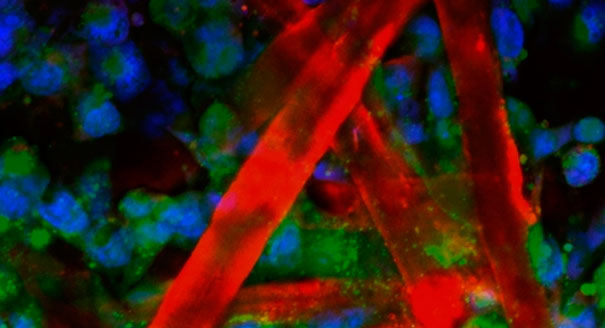The first 3d model of a tumour has been developed to study how cancers can survive with low levels of oxygen – a tool that will reveal more about the inner workings of cancers and help the development of new treatments.
Scientists from the MRC Cancer Unit at the University of Cambridge, working with researchers at the University of Toronto, created the 3d model by coating a thin surface with cancer cells, then rolling this up to create an environment where the innermost cells are deprived of oxygen.
 This establishes an oxygen gradient that mimics the same situation found within a tumour in the body. The researchers were then able to glimpse into the world of the tumour by rapidly unwinding the scaffold.
This establishes an oxygen gradient that mimics the same situation found within a tumour in the body. The researchers were then able to glimpse into the world of the tumour by rapidly unwinding the scaffold.
This revealed how the amount of oxygen varied within the tumour, and the implications this has on cell growth and treatment response. The researchers were also able to reveal the metabolic responses cancer cells make to survive in a low oxygen environment.
The lack of oxygen within a tumour – called hypoxia – is often down to the creation of new blood vessels lagging behind the cancers growth. To adapt to this, cells change their metabolic behaviour to cope, including their use of oxygen, to ensure continued growth and survival.
This response is controlled by a number of pathways so that some oxygen is able to permeate all the way through the tumour, ensuring that no cells die because they are completely starved of oxygen.
The 3d tumours also replicated a cancer’s response to treatment – levels of the common chemotherapy drug doxorubicin plateaued deeper into the tumour. The response to radiotherapy was also similar to that seen in humans where cells with low oxygen were less likely to die.
Dr Christian Frezza, the lead researcher from the MRC Cancer Unit, said: “Cancers grow rapidly, and to support this burst cells need to be able adapt in an environment where the supply of oxygen can’t keep up. While this phenomenon has been known for some time, gaining an experimental insight to the metabolic processes that the cells use to survive has proved a challenge.
“Our new model allows us to look at cellular metabolism in 3d and to see how a tumour response to low oxygen is tightly controlled and that without this control cells are unable to adapt and survive. Armed with this knowledge it could lead to the development of new treatments that target these oxygen deprived cancer cells, which can be the hardest to target and destroy.”
The study is published in Nature Materials.
Image: Cellular organization in the engineered tumour. Credit: Darren Rodenhizer


